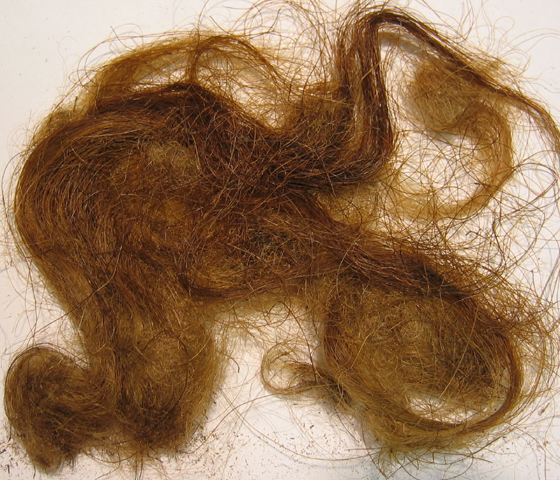
 |
 |
Freezing
 Mammoth Hair Mammuthus primigenius Pleistocene Taimyr, Siberia Russia |
|
During the last Ice Age some of these animals died in areas that have remained cold. Eventually, in rare instances, organisms were buried in what became permafrost soil. Bones, muscles, internal organs, partly digested food, skin and hair can sometimes be found. Both the course guard hair and soft underwool of the mammoth is represented in the specimen above. Some of the 30,000 year old woolly mammoths found are so fresh that they could be eaten by humans and animals (Prothero, 2004, p. 9). The Ice Baby In the spring of 2007 Yuri Khudi, a Nenet reindeer herder, discovered a baby Mammuthus primigenius exposed on a sandbar of the Yuribey River in Siberia. The 40,000 year old fossil mammoth was named Lyuba after Khudi's wife. Lyuba, nicknamed the Ice Baby, represents one of the best preserved fossils found to date in the permafrost of Siberia. Lyuba was one month old when she drowned in soft sediments of silt and clay. Paleontologist Dan Fisher has determined that more than just the frozen permafrost was essential in Lyuba's excellent preservation (Miller, 2009, p. 41). Lactobacilli colonized her tissues after death. The lactic acid produced by these bacteria acted as a preservative, pickling Lyuba's tissues. As new sediments accumulated above Lyuba the layers in which she was entombed turned to permafrost. Eventually, floodwaters eroded the permafrost that encased Lyuba and transported her downstream. The lactic acid that originally helped to preserve the tissues now protected the fossil from present day scavengers as it lay exposed on the sandbar. Thus, for Lyuba preservation by both chemical means and freezing were critical factors in the fossilization process.
Prothero, D.R. (2004). Bringing Fossils to Life: An Introduction to Paleobiology [2nd edition]. New York: McGraw-Hill. Rich P.V., Rich T. H., Fenton, M.A., & Fenton, C.L. (1996). The Fossil Book: A Record of Prehistoric Life. Mineola, NY: Dover Publications, Inc. Thompson,
I. (1982). National Audubon Society Field Guide to
Fossils. New York: Alfred A. Knopf. |










